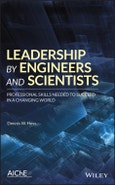Teaches scientists and engineers leadership skills and problem solving to facilitate management of team members, faculty, and staff
This textbook introduces readers to open-ended problems focused on interactions between technical and nontechnical colleagues, bosses, and subordinates. It does this through mini case studies that illustrate scenarios where simple, clear, or exact solutions are not evident. By offering examples of dilemmas in technical leadership along with selected analyses of possible ways to address or consider such issues, aspiring or current leaders are made aware of the types of problems they may encounter. This situational approach also allows the development of methodologies to address these issues as well as future variations or new issues that may arise.
Leadership by Engineers and Scientists guides and facilitates approaches to solving leadership/people problems encountered by technically trained individuals. Students and practicing engineers will learn leadership by being asked to consider specific situations, debate how to deal with these issues, and then make decisions based on what they have learned. Readers will learn technical leadership fundamentals; ethics and professionalism; time management; building trust and credibility; risk taking; leadership through questions; creating a vision; team building and teamwork; running an effective meeting; conflict management and resolution; communication; and presenting difficult messages.
- Describes positive traits and characteristics that technically-trained individuals bring to leadership positions, indicates how to use these skills, and describes attitudes and approaches necessary for effectively serving as leaders
- Covers negative traits and characteristics that can be detrimental when applied to dealing with others in their role as leaders
- Discusses situations and circumstances routinely encountered by new and experienced leaders of small teams
- Facilitates successful transitions into leadership and management positions by individuals with technical backgrounds
- Indicates how decisions can be reached when constraints of different personalities, time frames, economics, and organization politics and culture inhibit consensus
- Augments technical training by building awareness of the criticality of people skills in effective leadership
Leadership by Engineers and Scientists is an excellent text for technically trained individuals who are considering, anticipating, or have recently been promoted to formal leadership positions in industry or academia.
Table of Contents
Foreword by C. Judson King ix
Foreword by Rick Zalesky xi
Preface xiii
Acknowledgments xvii
Part I Introduction to Technical Leadership 1
1 Examples of Routine Problems and Decisions Faced by Technical Leaders 7
1.1 Possible Approaches to Deal with Representative Leadership Dilemmas 9
Reference 13
2 Technical Leadership Fundamentals 14
2.1 Leaders Versus Managers 16
2.2 Engineers and Scientists as Leaders 17
2.3 Leader Attributes/Characteristics 20
2.4 Ineffective Leadership Traits 21
2.5 Behaviors or Strategies Used by Effective Leaders 24
2.6 Practice Makes Perfect 28
2.7 Listening 29
2.8 Mentoring or Coaching 31
2.9 Leadership Styles 33
2.10 Fixed Versus Growth Mindset 37
2.11 Servant/Shared Leadership 38
2.12 Values 40
2.13 Emotional Intelligence 42
2.14 Stress 44
2.15 Summary 47
References 48
Homework Questions 50
3 Ethics and Professionalism 54
3.1 Ethics 56
3.2 Professionalism 57
3.3 Team or Organizational Culture 59
3.4 Character Ethics and Personality Ethics 63
3.5 Summary 64
References 64
Homework Questions 66
4 Time Management 74
4.1 Time Allocation 75
4.2 Planning and Organization 78
4.3 Personal Time for Leaders 83
4.4 Summary 83
References 84
Homework Questions 85
5 Building Trust and Credibility 87
5.1 Leader Behaviors that Establish (or Lose) Trust and Credibility 90
5.2 Leader-Boss or Leader-Supervisor Trust and Credibility 93
5.3 Summary 95
References 95
Homework Questions 96
6 Risk-Taking, Creativity, and Confidence 99
6.1 Risk-Taking 100
6.2 Creativity 104
6.3 Confidence 108
6.4 Summary 109
References 110
Homework Questions 111
Part II Putting Leadership Principles into Practice 115
7 Leadership Through Questions 117
7.1 Basis Behind Using Questions in Leadership 119
7.2 Questions that Encourage Rather than Discourage 123
7.3 Caution When Asking Questions 125
7.4 Summary 126
References 126
Homework Questions 127
8 Creating a Vision 129
8.1 Differences Between Vision and Mission 130
8.2 Vision Creation 132
8.3 Summary 135
References 135
Homework Questions 136
9 Team Building and Teamwork 138
9.1 Hiring or Appointing the Right Team Members 142
9.2 Leader Approaches to Effective Team Operation 145
9.3 Cross-Cultural Teams 149
9.4 Collegiality 150
9.5 Motivation 152
9.6 Summary 157
References 158
Homework Questions 160
10 Running Effective Meetings, Making Decisions, and Managing Change 164
10.1 Running an Effective Meeting 165
10.2 Making Decisions 169
10.3 Managing Change 173
10.4 Relationship Between Team Building and Change 178
10.5 Summary 179
References 180
Homework Questions 181
11 Conflict Management and Resolution 184
11.1 Causes of Conflict 185
11.2 Approaches to Control/Manage Conflict 186
11.3. Summary 191
References 191
Homework Questions 192
12 Communication 194
12.1 Verbal Communication (Presentations) 197
12.2 Written Communication (Emails, Memos, Reports) 201
12.3 Communicating with Nontechnical People 204
12.4 Summary 206
References 207
Homework Questions 208
13 Presenting Difficult Messages 211
13.1 Positive Approaches to Offering Negative Messages 213
13.2 Summary 216
References 217
Homework Questions 218
Appendix A Self Evaluation and Assessment 220
Appendix B List of Personal Values 221
Appendix C Codes of Ethics 223
C.1 American Chemical Society (The Chemical Professional’s Code of Conduct) 223
C.2 American Institute of Chemical Engineers (Code of Ethics) 225
C.3 American Physical Society (Guidelines for Professional Conduct) 226
C.4 American Society of Mechanical Engineers (Code of Ethics of Engineers) 229
C.5 Institute of Electrical and Electronics Engineers (Code of Ethics) 230
Index 232








